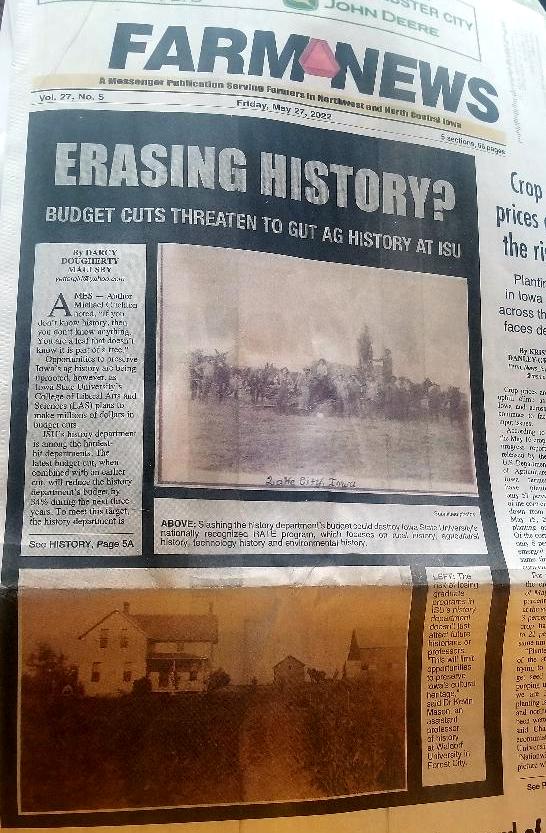
Whats HOT
Latest Posts
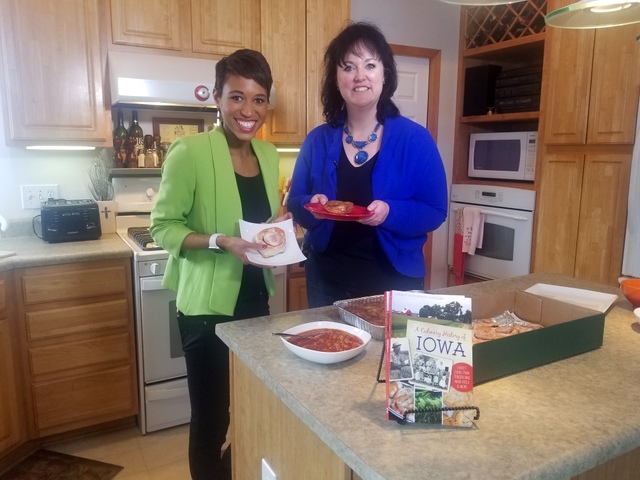
Are You on Team Cinnamon Roll?
It’s every marketer’s dream–a topic so compelling that no one can ignore it, and everyone wants to talk about it. Here in Iowa, this kind of topic revolves around that school-lunch classic–chili and cinnamon rolls.
Yep, it’s a thing, and it’s a beloved tradition here in my hometown of Lake City. I’ll never forget the comforting aroma of homemade rolls (caramel rolls, most of the time) filling the school, including our 1920s-vintage three-story high school. As if it weren’t hard enough to concentrate in math class, I had that enticing aroma to distract me–but oh what sweet torture!
I’m reliably informed that chili and cinnamon rolls are still a favorite school lunch in the local school district, as well as other schools around the state.
So when it was time to write the manuscript for my second book, “A Culinary History of Iowa,” I started talking to sources about the history of chili and cinnamon rolls. Not only did I discover that no one seems to remember the origins of this phenomenal combo, but it’s not something that every Iowa school kid grew up with.
Some people had never heard of it. Others said their school served peanut butter sandwiches with chili. There were those who couldn’t imagine chili without cornbread. Still others, including a friend from Minnesota, were revolted. “That makes no sense! That’s like eating scrambled eggs and birthday cake together!” said one Minnesota native.
Whether you love it or hate it, seems like everyone has an opinion about chili and cinnamon rolls. Click here for a snippet from my Culinary History of Iowa book to help whet your appetite about the history of chili and cinnamon rolls–along with an amazing recipe!
This food combo is also a surprisingly newsworthy topic. A reporter from the Des Moines Register interviewed me for the recent article “The history behind Iowa’s unique taste for chili and cinnamon rolls.”
The day after that story ran, I received an email from Jodi Long, a reporter for TV-13, the NBC affiliate in Des Moines. She wanted to do a segment on the history of chili and cinnamon rolls, so we filmed the segment last Friday. As soon as it aired on the early morning news segment this past Monday, I started getting comments, kudos and questions on Facebook and beyond.
(I love the Team Cinnamon Roll and Team Cornbread idea that Jodi included in her Facebook post. To watch the news segment, click here!)
I learned three things from this experience:
1. Realize that things you take for granted might be quite newsworthy, and look for ways to showcase these stories. (Your website, newsletter, e-newsletter, social media posts, press releases, videos, podcast or other communication tools might be just the place to share these stories.)
2. Respond quickly when the media wants to interview you about a topic. Reporters need to know sooner rather than later whether you can help them. Don’t miss the opportunity for free publicity.
3. Invite people to join the conversation. So I want to know–are you on Team Cinnamon Roll or Team Cornbread?
Want more?
Thanks for stopping by. I invite you to read more of my blog posts if you value intriguing Iowa stories and history, along with Iowa food, agriculture updates, recipes and tips to make you a better communicator.
If you like what you see and want to be notified when I post new stories, be sure to click on the “subscribe to blog updates/newsletter” button at the top of this page, or click here. Feel free to share this with friends and colleagues who might be interested, too.
Also, if you or someone you know could use my writing services (I’m not only Iowa’s storyteller, but a professionally-trained journalist with 20 years of experience), let’s talk. I work with businesses and organizations within Iowa and across the country to unleash the power of great storytelling to define their brand and connect with their audience through clear, compelling blog posts, articles, news releases, feature stories, newsletter articles, social media, video scripts, and photography. Learn more at www.darcymaulsby.com, or e-mail me at yettergirl@yahoo.com.
If you’re hungry for more stories of Iowa history, check out my top-selling “Culinary History of Iowa: Sweet Corn, Pork Tenderloins, Maid-Rites and More” book from The History Press. Also take a look at my latest book, “Dallas County,” and my Calhoun County” book from Arcadia Publishing. Both are filled with vintage photos and compelling stories that showcase he history of small-town and rural Iowa. Order your signed copies today! Iowa postcards are available in my online store, too.
Let’s stay in touch. I’m at darcy@darcymaulsby.com, and yettergirl@yahoo.com.
Talk to you soon!
Darcy
@Copyright 2019 Darcy Maulsby & Co. Blog posts may only be reprinted with permission from Darcy Maulsby.

From My Kitchen to Yours: Comfort Food, Conversation and Living History Farms
Ever get an email that jumps out at you? It happened me to last July when one arrived with the subject line “Greetings from Living History Farms.” It was from my friend, Jim Dietz-Kilen, a former classmate from the Ag-Urban Leadership Initiative, and his note intrigued me.
“I have an idea for your consideration,” wrote Jim, who is the vice president of development for Living History Farms (LHF). “We are planning our annual gala, Farmstasia. We try to put together unique experience packages for our auction, with emphasis on agriculture/rural life and Iowa history. My idea is to build a package around you. While I am very open to other ideas, I wanted to run the following request by you:
• Would you be willing to donate a signed book? Any of your books would be wonderful, but I am partial to the Culinary History of Iowa.
• Would you also be willing to host a family at your farm to show them a bit of what your lives are like?
• Finally, would you be willing to serve these guests a meal selected from your book?
I know this is asking a lot, Darcy, but I have learned that you never know until you ask. And, as Wayne Gretzky said, ‘Every shot you don’t take is a miss.'”
By this point, I was already brainstorming menu ideas.
I’m a big fan of LHF, which welcomes between 100,000 and 110,000 each year. This interactive, 500-acre outdoor museum that tells the amazing 300+ year story of how Iowans transformed the fertile prairies of the Midwest into the most productive farmland in the world. As I wrote in this blog for Latham Hi-Tech Seeds, I love how LHF encourages people of all ages to explore Iowa’s rural heritage, including the 1700 Ioway village, the 1850 pioneer farm, the 1875 town of Walnut Hill and the 1900 horse-powered farm.
“All proceeds from Farmstasia go to keep fees low for our education programs, helping make it possible for kids from across the state to come here for school visits and participate in other educational experiences,” Jim continued.
Jim knows what is near and dear to my heart. Iowa agriculture. Books. Classic Iowa farm cooking. LHF. Giving back to the community. Without hesitating, I said yes.

Living History Farms Iowa
Cookstoves, corncobs and storytelling
LHF came into my life in a big way in the summer of 1995, when my college internship led me to the 1900 farm, Flynn mansion and veterinary clinic, where I served as a historical interpreter and looked the part in my Victorian-inspired dresses and bonnets.
That summer changed my life in so many ways. I met my husband through this experience. I also expanded my cooking skills. By the end of the summer, I knew how to light a cookstove with crumpled newspapers and corncobs. I could make homemade noodles with no problem. I could bake cookies in an oven with no temperature gauge, other than the feel of the heat on your hand. I could milk a Jersey cow by hand and churn the cream into butter. I could plan a meal and feed a threshing crew. I could even run a treadle sewing machine and sew my own apron.
Looking back, I was a prepper in training who can live off the grid if I have to.
While I don’t use all those skills today, some have served me well for years, especially the cooking skills, the historical knowledge I gained and the storytelling skills I learned. As a historical interpreter, I was not only working in the kitchen of the 1900 farm fixing a meal, but I interacted with guests. As I shared stories about Iowa farm life in the early 1900s, I learned the importance of listening. I’m still embarrassed when I misunderstood one guest who asked, “Is that a coal stove?” but I heard him say, “Is that a cold stove?” so I replied, “No, it’s a warm one!”
Planning a memorable menu
I was thinking of those experiences last Saturday, February 16, when I delivered on my promise to provide the Farmtasia winning bidders with an authentic Iowa farm meal inspired by my book. I had actually started cooking the night before and then got up early on Saturday morning so I’d get everything done on schedule and have time to visit with my guests.
They pulled in the driveway at my family’s Century Farm near Lake City right on time. It was an honor to host Dave Bubeck, a corn breeder at Corteva Agriscience™ in Johnston; his wife, Denise; and their friends Ben and Michelle Parlett, who also live in the Des Moines area. As we gathered around the table at noon, I served:
• Garden Vegetable Soup
• Homemade Beer Bread
• Iowa Ham Balls
• Glazed Meat Loaf
• Garlic Cheesy Smashed Potatoes
• Relish tray and coleslaw salad
• Homemade apple crisp with Haralson apples grown on our farm
There was something magical happened as we sat in that 100+plus-year-old kitchen, talking farming, food, travel and LHF. Seems like we covered everything, from how to talk about GMOs to what it’s like subscribing to a meal delivery service. Two and a half hours later, when my guests departed, we all agreed it was a great experience—the kind of story-worthy experience that LHF inspires. Even better, we’re staying in touch through social media and my e-newsletter.
And to think it all started with a simple email and a spirit of service. It reminds me of this quote from Orison Swett Marden, who founded SUCCESS magazine in 1897.
“We must give more in order to get more. It is the generous giving of ourselves that produces the generous harvest.”
Let’s get cooking
If you’d like to create a taste of our classic Iowa farm dinner, here are some of my favorite recipes:

Hearty Homemade Vegetable Soup
Hearty Garden Vegetable Soup
I shared this tasty recipe in one my my monthly diary entries in 2018 for the Iowa Food and Family Project.
1 tablespoon olive oil
8 medium carrots, sliced
3 large onions, chopped
5 celery ribs, chopped
1 large green pepper, seeded and chopped
1 garlic clove, minced
2 cups chopped cabbage
2 cups frozen cut green beans (about 8 ounces)
2 cups frozen peas (about 8 ounces)
1 can (15 ounces) corn, or 2 cups fresh sweet corn
1 can (28 ounces) diced tomatoes, undrained
2 bay leaves
2 teaspoons chicken bouillon granules
1-1/2 teaspoons dried parsley flakes
1 tablespoon seasoning salt
1 teaspoon dried marjoram
1 teaspoon dried thyme
1/2 teaspoon dried basil
1/2 teaspoon pepper
7 cups water
1 teaspoon Worcestershire sauce
4 cups V8 vegetable juice
In a stockpot, heat oil over medium-high heat; sauté carrots, onions, celery and green pepper until crisp-tender. Add garlic; cook and stir 1 minute. Stir in remaining ingredients; bring to a boil. Reduce heat; simmer, covered, until vegetables are tender, 1 to 1-1/2 hours. Remove bay leaves.
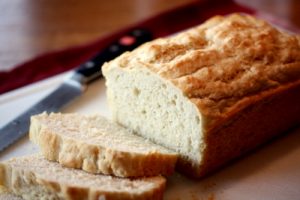
Best Beer Bread
Best Beer Bread
2 cups self-rising flour
2 1 / 2 tablespoons sugar
1 12-ounce can of beer
Mix all ingredients together. Pour batter into a greased loaf pan. Bake at 350 degrees for 45 to 50 minutes.

Iowa Ham Balls
Iowa Ham Balls
This tasty, classic recipe comes from my friend Val Plagge, who is a wonderful farm cook.
2.5 pounds ham
2 eggs
1 1/2 cups graham cracker crumbs
1 cup milk
1 can tomato soup
3/4 cup brown sugar
1/4 cup white vinegar
1 teaspoon ground mustard
With a food processor, grind ham into small, chopped pieces (or buy ham loaf mix from local grocery store or butcher. This mix usually contains ham and ground pork, and sometimes ground beef, too). Add eggs, graham cracker crumbs and milk. Mix together with your hands, and form fist-sized ham balls. (If the mixture seems a little dry, add 1/4 cup of milk at a time, up to 1 1/2 cups of milk total.) Place ham balls in a greased 9-inch by 13-inch pan. They fit nicely three across and five down.
Mix soup, brown sugar, vinegar and mustard until smooth. Drizzle glaze over the ham balls for the classic ham ball sauce. (Or, if you’re in a rush, drizzle your favorite barbecue sauce over the ham balls.) Bake at 350 Fahrenheit for 1 hour. Yield: 13-15 ham balls
Note: These ham balls freeze well and can be warmed up in a slow cooker, if desired. Ham balls are the perfect Iowa potluck treat!
Cheesy Garlic Mashers
Taking a twist on classic mashed potatoes, this recipe is loaded with flavor and offers the perfect comfort food.
Red Bliss or Yukon gold potatoes (use about one potato per person, although this will depend on the size of the potatoes)
6 garlic cloves (can use less, if you prefer)
Butter, 1 / 2 stick
Cream (use enough to give mashed potatoes the consistency you prefer)
1 carton sour cream (can substitute one carton of chip dip, if you prefer)
1 / 2 cup to 1 cup of Cheddar cheese
Seasoning salt and pepper, to taste
Chives, chopped
Bacon, 2 to 3 slices, fried
Boil potatoes in salted water with peeled, whole garlic cloves. When potatoes are done cooking, drain potatoes and garlic and place in a bowl with butter and cream. Mash together. Add more cream, if necessary, to achieve the consistency you prefer. Mix in sour cream and cheddar cheese. Season to taste with seasoning salt and pepper. Garnish with chopped chives and real bacon bits.
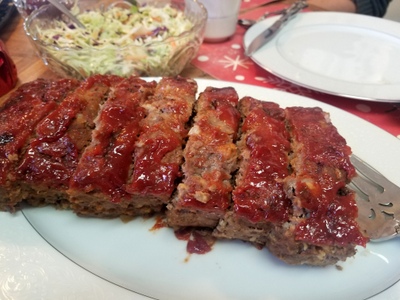
Glazed Meatloaf
Darcy’s Best Brown-Sugar Meatloaf
This recipe was inspired by the meatloaf that caterers prepared on the set in Iowa for the filming for “The Bridges of Madison County.” This is the only meatloaf recipe you’ll ever need!
1 pound ground beef
1 pound ground pork or ground turkey
1 cup herb-seasoned stuffing mix
1 onion, chopped
1 teaspoon salt
1/2 teaspoon freshly-ground pepper
1 teaspoon nutmeg
2 large eggs, lightly beaten
3 / 4 cup milk
2 tablespoons barbecue sauce
1 / 4 cup ketchup
2 tablespoons brown sugar
1 teaspoon dry mustard
Combine beef, pork or turkey, stuffing mix, onion, salt, pepper and nutmeg. In a separate bowl, beat eggs, milk, and barbecue sauce. Add to meat mixture, mixing well. Press into a meatloaf pan sprayed with non-stick cooking spray.
Combine ketchup, brown sugar, and mustard; spread over top of meat loaf. Bake, uncovered, at 350 degrees F for 1 hour and 30 minutes or until a thermometer inserted in the center of the loaf registers 160 degrees. Yield: 6 servings
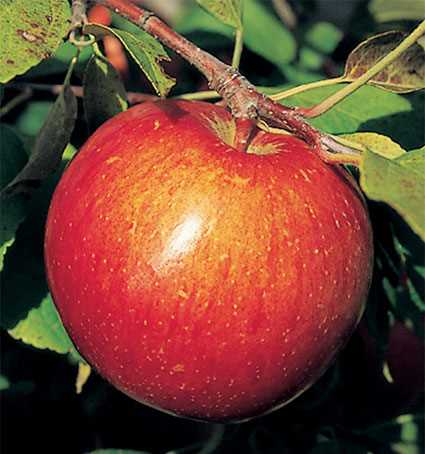
Haralson apple photo from Jung Seed
Farm-Fresh Apple Crisp with Whipped Cream
If you have the chance to visit a local apple orchard, pick up some Haralson apples, if they are available. We grow Haralsons on our farm, and their sweet-tart flavor works perfectly in apple pies and apple crisps.
Fruit Filling:
6 baking apples, peeled, cored and cut into wedges
1 tablespoon lemon juice
1 / 2 cup sugar
2 tablespoons flour (maybe need more, depending on how juicy the apples are)
Crumb topping:
1 1 / 4 cups flour
1 / 2 cup rolled oats
1 / 2 cup light brown sugar
1 / 2 teaspoon ground cinnamon
1 / 4 teaspoon salt
12 tablespoons butter (1 1/2 sticks), cut into small pieces
Preheat the oven to 350 degrees Fahrenheit.
For the fruit filling:
In a large mixing bowl, toss together the apples, lemon juice, sugar, and flour. Pour the apple mixture into a buttered 2-quart baking dish and set aside.
For the topping:
In a large mixing bowl, mix the flour, rolled oats, brown sugar, cinnamon, and salt. With a pastry blender, work the butter into the flour mixture just until mixture comes together and pea-sized clumps form.
Sprinkle the topping evenly over the fruit. Bake the apple crisp until the fruit is bubbling and the topping is golden brown and crisp, about 45 minutes.
Serve the crisp warm with vanilla bean ice cream or fresh whipped cream, if desired.
To make whipped cream, pour 1 cup of whipping cream into metal bowl on stand mixer. (Chill the bowl and whip attachment in the refrigerator first.) Begin mixing on high speed. As the cream starts to form into whipped cream, add powdered sugar a tablespoon at a time, until you achieve the sweetness you desire. Continue mixing on high until the mixture looks like thick whipped cream. Serve with apple crisp.
Want more?
Thanks for stopping by. I invite you to read more of my blog posts if you value intriguing Iowa stories and history, along with Iowa food, agriculture updates, recipes and tips to make you a better communicator.
If you like what you see and want to be notified when I post new stories, be sure to click on the “subscribe to blog updates/newsletter” button at the top of this page, or click here. Feel free to share this with friends and colleagues who might be interested, too.
Also, if you or someone you know could use my writing services (I’m not only Iowa’s storyteller, but a professionally-trained journalist with 20 years of experience), let’s talk. I work with businesses and organizations within Iowa and across the country to unleash the power of great storytelling to define their brand and connect with their audience through clear, compelling blog posts, articles, news releases, feature stories, newsletter articles, social media, video scripts, and photography. Learn more at www.darcymaulsby.com, or e-mail me at yettergirl@yahoo.com.
If you’re hungry for more stories of Iowa history, check out my top-selling “Culinary History of Iowa: Sweet Corn, Pork Tenderloins, Maid-Rites and More” book from The History Press. Also take a look at my latest book, “Dallas County,” and my Calhoun County” book from Arcadia Publishing. Both are filled with vintage photos and compelling stories that showcase he history of small-town and rural Iowa. Order your signed copies today! Iowa postcards are available in my online store, too.
Let’s stay in touch. I’m at darcy@darcymaulsby.com, and yettergirl@yahoo.com.
Talk to you soon!
Darcy
@Copyright 2019 Darcy Maulsby & Co. Blog posts may only be reprinted with permission from Darcy Maulsby.
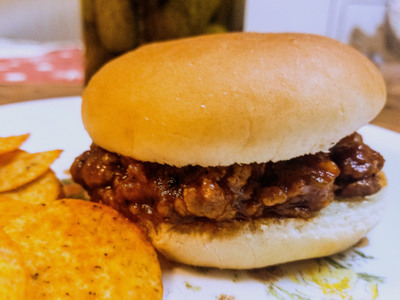
Tex-Mex Sloppy Joes and the Magic of Maid-Rite in Iowa
From time to time I get calls from around Iowa or across the country, usually from the media, about the history of Iowa food. Even the Travel Channel reached out for an upcoming Iowa episode of Bizarre Foods: Delicious Destinations. (Don’t miss this cool story!) People usually want to talk about one thing—Maid-Rites. I love sharing this story and have also cooked up my own twist on loose-meat sandwiches.
Just the other day a friend emailed me about Maid-Rites, wanting to know some other names for the sandwich. Here’s what I told her:
* Loose-meat sandwiches
* Taverns (a common term around Sioux City and parts of northwest Iowa)
* Beef burgers
* Canteens (in Ottumwa)
* Sloppy Joes (if they contain ketchup and other goodies in the mix)
* Yip-yips (at least in southern Illinois, or so I’ve been told!)
While you can sometimes find these sandwiches on some café menus in Iowa, as well as at the 30+ Maid-Rite chain restaurants around the Midwest, they are often turn up at potlucks, fundraiser meals, family get-togethers, civic group lunches and more.
Just when I think I’ve seen every type of these loose-meat sandwiches, there’s another version that pops up. When I shared my “How to Take Better Photos in 1 Minute” class with the Rockwell City Rotary Club recently, the meal included Tex-Mex inspired sloppy joes. While I don’t normally care for sloppy joes, I absolutely loved these sandwiches.
I loved them so much I was inspired to create my own version. These are flavorful, stick-to-your-ribs sandwiches that come together in a snap and can be as spicy or as mild as you like. They’re also an ultimate comfort food on these cold winter days here in Iowa.
Here’s the recipe. Enjoy! Also, keep reading below for the fascinating history of Maid-Rite in Iowa. This is an excerpt from my 2016 book, “Iowa’s Culinary History: Sweet Corn, Pork Tenderloins, Maid-Rites & More.” Order here to get your own signed copy of this fun book!
Tex-Mex Sloppy Joes
• 1 pound ground beef
• 1 small onion, chopped
• 2 garlic cloves, minced
• 1 cup ketchup
• 1 can (4 ounces) chopped green chilies
• 1/2 cup beef broth
• 1/4 cup chili sauce
• 1/2 to 1 teaspoon chili powder, to taste
• 1/2 teaspoon ground cumin
• 1/4 teaspoon crushed red pepper flakes, optional
• 1/4 teaspoon salt
• 1/4 teaspoon coarsely ground pepper
• 6 hamburger buns, split
• 2 tablespoons butter, softened
In a large skillet, cook beef and onion over medium heat for 6-8 minutes or until beef is no longer pink, breaking up beef into crumbles; drain. Add garlic; cook 1-2 minutes longer. Stir in the ketchup, chilies, broth, chili sauce and seasonings. Bring to a boil. Reduce heat; simmer, uncovered, for 15 minutes, stirring occasionally.
Meanwhile, spread cut sides of buns with butter. Place on baking sheets, buttered side up. Broil 4 in. from the heat for 1-2 minutes or until toasted. Serve beef mixture in buns.
Now for a tasty bite of Iowa history
Call it the king of the loose-meat sandwiches. A tried-and-true Iowa classic for nearly 100 years, the Maid-Rite is a sandwich unlike any other. But first, let’s clarify what a Maid-Rite is not.
It’s not a sloppy joe. It’s not a ground-beef concoction with ketchup, mustard and sugar in the mix. (Some of these “hybrid” sandwiches with traits of both a Maid-Rite and a sloppy joe can be found in Iowa, and some are quite tasty, but a true Maid-Rite they are not.) Finally, a Maid-Rite is not something you can leave out if you’re going to delve into the culinary history of Iowa.
The story of the Maid-Rite began in 1926, when Fred Angell, a meat cutter in Muscatine, developed a recipe with just the right combination of ground beef (with a specific grind size and meat/fat ratio) and a distinctive seasoning featuring Fred’s unique blend of spices. When a deliveryman tasted Fred’s new creation, he exclaimed, “This sandwich is made right!”
With that, the Maid-Rite legend was born. “The Maid-Rite recipe has stayed the same from the beginning,” said Bradley Burt, president and CEO of the Maid-Rite Corporation based in West Des Moines. “There’s no other sandwich like ours.”
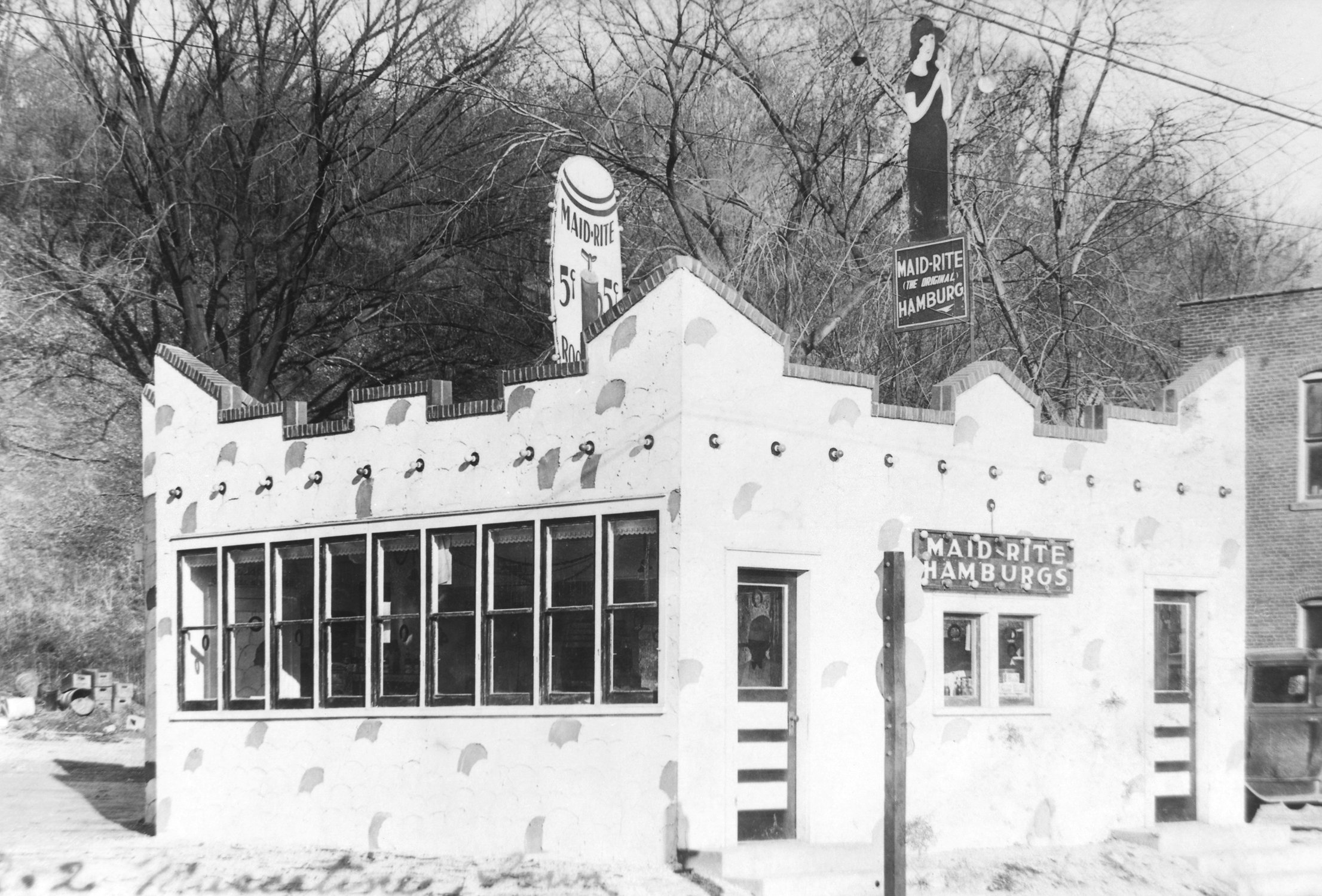
Early Maid-Rite sandwich shop. Photo courtesy of Maid-Rite Corp.
What started as a small Maid-Rite restaurant in Muscatine grew into one of America’s first quick-service, casual-dining franchise restaurants. Today there, are restaurants in eight Midwestern states, including 38 stores in Iowa. While the days of 5-cent Maid-Rites and homemade root beer are gone, Maid-Rite continues to pride itself on home-town hospitality. “Maid-Rite restaurants are still a gathering place in many small towns,” Burt said.
Some of these restaurants are as rich in history as the Maid-Rite sandwich itself. Taylor’s Maid-Rite in Marshalltown is a third-generation business that has been serving central Iowa for more than 80 years. Cliff Taylor purchased the 1928 franchise for $300. Cliff and his family operated Taylor’s Maid-Rite Hamburger Shop, baking pies at home, slicing whole pickles from Marshall Vinegar Works and buns from Strand’s Bakery.
After Cliff passed away in 1944, his son, Don, continued to run the restaurant. Don built a cooler in the basement of his home to store the hamburger that was ground daily. In 1958, he built a state-of-the-art Maid-Rite restaurant across the street from the original location, outfitting the new store with all stainless-steel equipment and two cash registers.
While various generations of the family have operated the business since then, many things haven’t changed. Like all Maid-Rite restaurants, each Maid-Rite at Taylor’s is made from 100% USDA Midwestern fresh ground beef served on a bun, with your choice of ketchup, mustard, onion and pickles. “We have stringent specifications for our beef,” Burt said.
Once you’ve tasted a real Maid-Rite, there’s no substitute. Many former Iowans don’t consider themselves to be officially back home in Iowa until they’ve eaten a Maid-Rite. “It’s quite a phenomenon,” Burt wait. Some Iowans can’t wait to get a taste of home. A group of snowbirds who spend their winters in Arizona host a Maid-Rite party in the Phoenix area each year for 150 guests, complete with Maid-Rite hats, t-shirts and aprons.
One of the biggest Maid-Rite fans of all would have to be Jim Zabel, who broadcast University of Iowa athletic events for 50 years. Before his passing in 2013, the legendary sportscaster and ultimate Iowa ambassador served as the Maid-Rite spokesman. He even made a commercial for Maid-Rite, complete with a riff on his high-energy slogan, “I love ‘em, I love ‘em, I love ‘em!”
Many Iowans stay loyal to their beloved Maid-Rites right to the end. Some people request them as their final meal, while others ask that Maid-Rites be served at their funeral dinner. “Maid-Rite is truly part of Iowa’s culture,” Burt said.
Want more?
Thanks for stopping by. I invite you to read more of my blog posts if you value intriguing Iowa stories and history, along with Iowa food, agriculture updates, recipes and tips to make you a better communicator.
If you like what you see and want to be notified when I post new stories, be sure to click on the “subscribe to blog updates/newsletter” button at the top of this page, or click here. Feel free to share this with friends and colleagues who might be interested, too.
Also, if you or someone you know could use my writing services (I’m not only Iowa’s storyteller, but a professionally-trained journalist with 20 years of experience), let’s talk. I work with businesses and organizations within Iowa and across the country to unleash the power of great storytelling to define their brand and connect with their audience through clear, compelling blog posts, articles, news releases, feature stories, newsletter articles, social media, video scripts, and photography. Learn more at www.darcymaulsby.com, or e-mail me at yettergirl@yahoo.com.
If you’re hungry for more stories of Iowa history, check out my top-selling “Culinary History of Iowa: Sweet Corn, Pork Tenderloins, Maid-Rites and More” book from The History Press. Also take a look at my latest book, “Dallas County,” and my Calhoun County” book from Arcadia Publishing. Both are filled with vintage photos and compelling stories that showcase he history of small-town and rural Iowa. Order your signed copies today! Iowa postcards are available in my online store, too.
Let’s stay in touch. I’m at darcy@darcymaulsby.com, and yettergirl@yahoo.com.
Talk to you soon!
Darcy
@Copyright 2019 Darcy Maulsby & Co. Blog posts may only be reprinted with permission from Darcy Maulsby.

Warm Up with Homemade Macaroni and Cheese Soup
It’s 10 degrees outside here in Iowa, the mercury is falling, it’s snowing, the wind is blowing, and I feel invincible—because I have a warm kettle of Mac and Cheese Soup on the stove.
“Soup puts the heart at ease, calms down the violence of hunger, eliminates the tension of the day, and awakens and refines the appetite,” noted Auguste Escoffier, the “chef of kings and king of chefs.”
I couldn’t agree more. Ask me my favorite thing to cook, and the answer is almost always soup. While I love proven recipes, I also like experimenting in the kitchen, like I did today. I made a batch of homemade macaroni and cheese a couple days ago that didn’t turn out quite as creamy as I wanted. I also had a small portion of leftover bacon mac and cheese from a recent meal at the Wild Rose Casino in Jefferson. What to do?
Hmmmm, could I combine these into mac and cheese soup? Is there such a thing as mac and cheese soup?
If not, let’s create it!
After a quick Google search for some culinary inspiration, I came up with a game plan. Since soup-making is more of an art than a science, I always tell people my recipes aren’t rules, just suggestions. You can reduce the milk if you like a thicker soup. Add more salt or pepper if you like. Enjoy a certain vegetable that’s not on the ingredient list? Try adding it. Do what makes sense to you.
A few cooking tips I do encourage:
• Use a pepper grinder to add fresh-ground pepper to your soup. I like to use a mix of red, black, green and white peppercorns for extra flavor.
• Do include the diced peppers. While I used a green pepper, you can user red, orange or yellow peppers, jalapenos, or whatever you have on hand. Peppers enhance the flavor, keep this soup from tilting to the blah side, and help you add extra veggies to your meal. Triple win!
• Go heavy on the onions when making soups. Alice Ann Dial, a neighbor and fantastic farm cook from my hometown of Lake City, Iowa, taught me to not skimp on onions. “They’re cheap and add so much flavor,” said Alice Ann, who learned this cooking trick during her days as a college student at Iowa State in Ames.
• You can make soup a day ahead of time and chill it in the refrigerator until you’re ready to serve. Many soups develop more flavor when they sit overnight, although my Mac and Cheese Soup is packed with flavor right from the start.
The main thing is to keep a spoon handy when you’re making soup, and taste as you go. Remember, you’re creating something special for you and the people you love. Tailor it just the way you like as you create a homemade batch of creamy, hearty, filling soup, perfect for a cold winter night or any time you just want a little extra comfort in your life.
Now please excuse me while I prepare supper and serve Mac and Cheese Soup for my family. Soup’s on!
Hearty Macaroni and Cheese Soup
Mac and Cheese Soup is creamy and oh-so-satisfying, just like mac and cheese. If you’re a mac and cheese fan, this soup is sure to become a favorite.
4 tablespoons butter
2 stalks celery, chopped
2 onions, chopped
2 cloves garlic, minced
2 carrots, grated or diced
1 green pepper, chopped
3 tablespoons all-purpose flour
4 cups chicken broth or vegetable broth
2 to 3 cups milk or half-and-half
1 teaspoon dry mustard
1 teaspoon Worcestershire sauce
1 / 2 teaspoon freshly ground pepper
1 / 4 teaspoon hot pepper sauce
Leftover macaroni and cheese
Bacon, cooked and chopped (optional)
OR
2 cups uncooked small pasta shells
8 ounces Velveeta cheese, cut into cubes
1 cup (4 ounce) shredded cheddar cheese
Melt butter in a Dutch oven or large pot. Add celery, onion, garlic, carrots and green pepper. Sauté until vegetables are soft.
Sprinkle flour on top of vegetable mixture. Whisk together and cook 1 minute.
Gradually whisk in chicken broth and milk. Bring to a simmer. Add dry mustard, Worcestershire sauce, pepper, and hot pepper sauce. Continue to simmer until soup thickens some. Add bacon, if desired.
This next step depends on whether you’re adding leftover macaroni and cheese, or you’re working with uncooked macaroni and the various cheeses. If you have leftover mac and cheese, it to the soup, let simmer for about 20 to 30 minutes, and serve.
If you don’t have leftover mac and cheese, cook pasta shells to al dente in salted water. The pasta will cook a little more in the soup and will absorb liquid, so be careful not to overcook.
Add cubes of Velveeta and stir until melted. Remove soup from heat and stir in cheddar cheese. Stir in cooked pasta, and serve. Enjoy!
Want more?
Thanks for stopping by. I invite you to read more of my blog posts if you value intriguing Iowa stories and history, along with Iowa food, agriculture updates, recipes and tips to make you a better communicator.
If you like what you see and want to be notified when I post new stories, be sure to click on the “subscribe to blog updates/newsletter” button at the top of this page, or click here. Feel free to share this with friends and colleagues who might be interested, too.
Also, if you or someone you know could use my writing services (I’m not only Iowa’s storyteller, but a professionally-trained journalist with 20 years of experience), let’s talk. I work with businesses and organizations within Iowa and across the country to unleash the power of great storytelling to define their brand and connect with their audience through clear, compelling blog posts, articles, news releases, feature stories, newsletter articles, social media, video scripts, and photography. Learn more at www.darcymaulsby.com, or e-mail me at yettergirl@yahoo.com.
If you’re hungry for more stories of Iowa history, check out my top-selling “Culinary History of Iowa: Sweet Corn, Pork Tenderloins, Maid-Rites and More” book from The History Press. Also take a look at my latest book, “Dallas County,” and my Calhoun County” book from Arcadia Publishing. Both are filled with vintage photos and compelling stories that showcase he history of small-town and rural Iowa. Order your signed copies today! Iowa postcards are available in my online store, too.
Let’s stay in touch. I’m at darcy@darcymaulsby.com, and yettergirl@yahoo.com.
Talk to you soon!
Darcy
@Copyright 2019 Darcy Maulsby & Co. Blog posts may only be reprinted with permission from Darcy Maulsby.

Homemade Mac and Cheese Soup
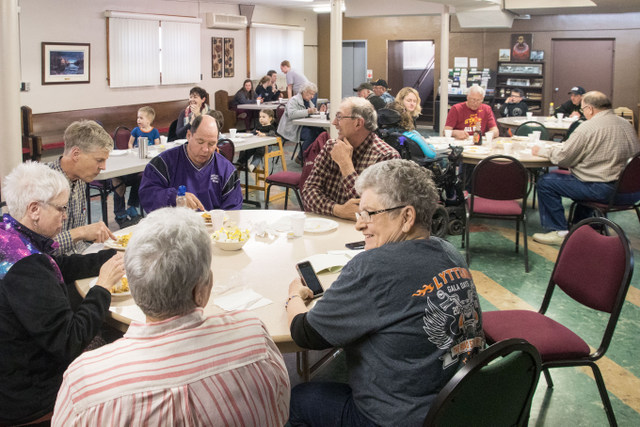
Doing Good, Eating Good at Lytton Town Night
What’s the glue that keeps a community connected? Around Lytton, Iowa, it’s food and fun at Lytton Town Night–and the homemade pie, of course.
While Lytton, Iowa, celebrates Gala Days each year during Memorial Day weekend, planning and fundraising for this beloved 100+ year tradition starts months earlier. In fact, a key part of the process starts in that most iconic of all small-town gathering places—the church basement.

Emanuel-St John Lutheran Church in Lytton, Iowa, hosts Lytton Town Night meals throughout the winter.
The basement dining area at Emanuel-St John Lutheran Church, whose congregation has roots dating back to 1883, provides a convenient setting for Lytton Town Night, which is held each Thursday evening from mid-January through March. Each Town Night offers a unique opportunity for the community to come together for free-will-donation meal to raise money for various causes and organizations, including Gala Days.
“Town Night is great, because there are a lot of fabulous cooks around Lytton,” said Nelda Bartels, a lifelong Lytton-area resident who often volunteers at Town Night.
As word of Town Night has spread through the years, guests come not only from Lytton, but Lake City, Sac City, Rockwell City and beyond. It’s not uncommon to serve a few hundred people at each meal.
“It’s like one big family when everyone gets together,” said Wendy Miller with the Lytton Chamber of Commerce.
Lytton Town Night includes groups like the Gala Days volunteers, the South Central Calhoun FFA chapter, 4-H clubs, civic groups and individuals raising money for worthy causes, including overseas mission trips. The Lytton Chamber of Commerce coordinates the schedule for Town Night, which allows eight to 10 different groups and individuals to host a Town Night meal during the winter, complete with home-cooked food. Some groups serve a selection of pasta casseroles, while others like the local FFA members serve pancakes and sausage links.
“I like the food, because it’s all good,” said Randy Souder, a Lytton-area farmer. “It’s also affordable, so everyone can come.”
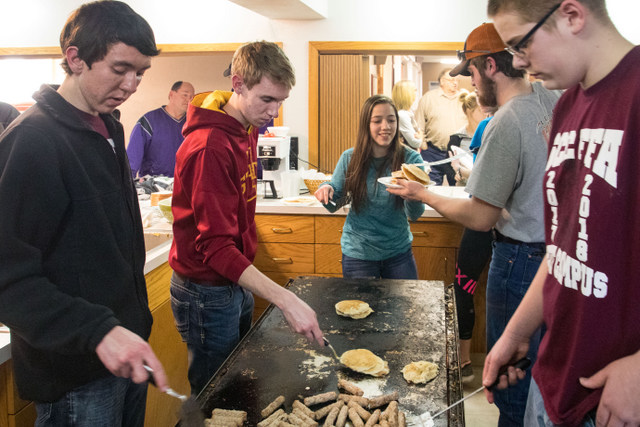
Members of the South Central Calhoun FFA chapter cooked pancakes and sausage during a Lytton Town Night fundraiser.
While no one is quite sure when Lytton Town Night started, it has been around since at least 1980, according to local-time residents. “It’s such a fun event, because you get to visit with friends and neighbors you don’t always see,” said Marlene Glasnapp, who lives with her husband, Roger, on a farm south of Lytton and is known as one of the best pie bakers in the area.
Each Town Night event is promoted through the Lytton Town Crier and on social media through Facebook. Each meal runs from 5 p.m. to 7 p.m. each Thursday evening during the winter. The popular gatherings attract people of all ages, from babies to grandparents.
Some groups, like the Gala Days volunteers, serve a lunch and a dinner meal when it’s their turn to host Town Night. “We usually have casseroles and homemade pie,” Bartels said. “The homemade pie is the kicker, because it’s always a hit.”
When the meal is done, the fellowship continues in downtown Lytton at the 1950s-era American Legion hall for bingo. “Town Night bingo has been called Lytton’s winter sport,” Bartels said.
The evening of bingo lasts about an hour and a half, and participants can play as many cards as they want. Two cards cost $3, and the proceeds support the American Legion.
Town Night isn’t just a fun evening, added Brian Lantz, an ag instructor at South Central Calhoun High School who advises the local FFA chapter. “It’s a local tradition, plus the kids learn how to work with the public when it’s their turn to cook and serve the meal.”
Keeping the Town Night tradition alive is important to residents of Lytton, which has a population of 302 residents. “Every year we wonder if we’ll be able have Town Night again,” Miller said. “We’re going to keep it going as a long as we can.”

Creamy Chicken Pasta Casserole
Creamy Chicken Casserole
This simple, hearty dish from Nelda Bartels of Lytton was served at the Gala Days fundraiser at Lytton Town Night in March 2018.
3 boneless, skinless chicken breasts, cooked and shredded
1 teaspoon garlic powder
1 tablespoon olive oil
1 10.75-ounce can cream of chicken soup
1 10.75-ounce can cream of mushroom soup
1 cup milk
1 bag (2 cups) shredded Cheddar cheese
1 / 2 teaspoon ground black pepper
1-pound box elbow macaroni (cooked according to package directions)
1 1 / 2 cups panko bread crumbs or regular bread crumbs
Preheat oven to 350 degrees. Cook chicken with garlic powder. (Nelda uses a programmable pressure cooker and adds a couple cups of chicken broth.) Drizzle with olive oil. When done, shred chicken with a fork, and save the juice.
Combine the two cream soups, milk, cheese, cooked chicken, broth from chicken and pepper. (If desired, add some sour cream or cream cheese into the mixture for extra flavor and creaminess.) Add cooked macaroni. Stir the mixture and pour into a 9-inch by 13-inch casserole pan.
Top casserole with panko breadcrumbs. Bake at 350 degrees for 20 to 25 minutes. Brown panko topping under broiler on low for 3 to 5 minutes. Watch closely, since the breadcrumbs can burn quickly.
Bowtie Lasagna Casserole
This tasty recipe comes from Nelda Bartels of Lytton.
1 jar spaghetti sauce
1 to 1.5 pounds ground beef
1 package bowtie pasta noodles (cooked according to package directions)
1 small carton cottage cheese
1 8-ounce package cream cheese
1 small carton sour cream
Mozzarella cheese
Preheat oven to 350 degrees. Brown hamburger; mix with spaghetti sauce. Pour sauce on bottom of 9-inch by 13-inch baking pan. Combine hamburger and bowtie pasta. Combine cottage cheese, cream cheese, and sour cream. Add to hamburger/pasta mix; pour in baking pan. Top with mozzarella cheese.
Bake at 350 degrees for 45 minutes to 1 hour.
Poppy Seed Chicken
This recipe comes from Susan Albright of Lytton.
4 chicken breasts, cooked and cubed
1 carton (16 ounces) sour cream
1 10.75-ounce can cream of chicken soup
Very small handful of spaghetti, broken into pieces and cooked (Susan Albright uses three fourths of a box of angel hair pasta)
1 stick butter
40 Ritz crackers, crushed
1 / 2 tablespoon poppy seeds
Preheat oven to 350 degrees. After cooking chicken, season to taste with garlic salt and onion. Combine sour cream and soup. Add cubed chicken and cooked spaghetti to mixture. Add salt, to taste.
Pour mixture into greased, 9-inch by 13-inch baking dish.
In a separate bowl, melt butter; add crushed crackers and poppy seeds. Sprinkle cracker mixture on top of casserole. Bake for 20 minutes.
Pie Crust
For decades, Marlene Glasnapp of rural Lytton has relied on this recipe, which yields approximately 6 crusts per batch.
5 cups flour
1 teaspoon salt
1 pound lard
1 cup water
Combine flour and salt. Cut lard into the flour mixture. Add water, a little at a time, mixing quickly and evenly until dough just holds together in a ball. Divide dough for six crusts. (The crusts can be frozen for later use, and Marlene often rolls hers out before freezing.)
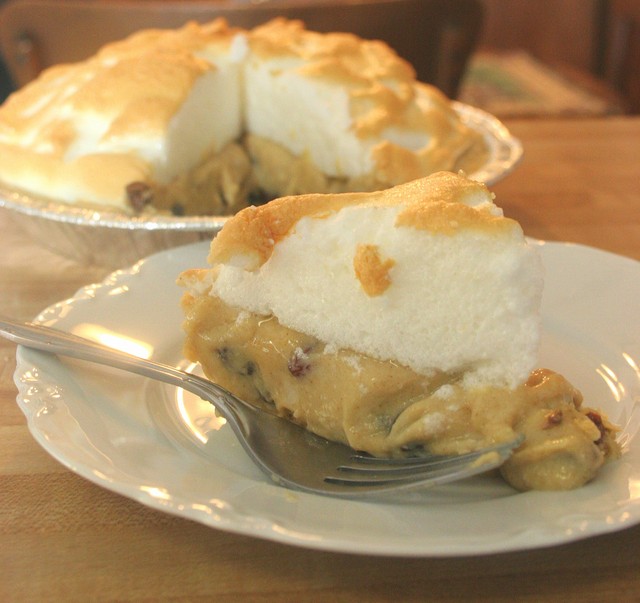
Raisin Cream Pie
Marlene Glasnapp’s raisin cream pie is always a hit wherever it’s served.
1 cup granulated sugar
3 tablespoons flour
1 / 2 teaspoon salt
1 teaspoon cinnamon
2 cups half-and-half
3-4 egg yolks (depends on the size of the eggs)
1 cup raisins
Mix dry ingredients with 1 / 2 cup of half-and-half, and set aside. Whisk egg yolks, and combine remaining half-and-half with the yolks. Add this mixture to the pie filling mix you set aside earlier.
Add raisins to the mixture and stir over medium heat until thick. Cool slightly. Pour in baked pie shell and top with meringue.
Meringue
1 tablespoon cornstarch
1 / 2 cup plus 1 tablespoon water
3 to 4 egg whites (depending on the size of the eggs)
3 to 4 tablespoons granulated sugar
Dissolve 1 tablespoon of cornstarch in 1 tablespoon of water. Boil 1 / 2 cup water and add to cornstarch mixture. Cook until clear. (This can be done in the microwave.) Beat egg whites and gradually add sugar. Add cooled cornstarch mixture and beat to proper consistency. Spread meringue over top of pie, sealing to the edge. Bake pie at 350 degrees Fahrenheit until meringue has browned.
Note from Darcy: I first wrote this piece in 2018 for Farm News.
Want more?
Thanks for stopping by. I invite you to read more of my blog posts if you value intriguing Iowa stories and history, along with Iowa food, agriculture updates, recipes and tips to make you a better communicator.
If you like what you see and want to be notified when I post new stories, be sure to click on the “subscribe to blog updates/newsletter” button at the top of this page, or click here. Feel free to share this with friends and colleagues who might be interested, too.
Also, if you or someone you know could use my writing services (I’m not only Iowa’s storyteller, but a professionally-trained journalist with 20 years of experience), let’s talk. I work with businesses and organizations within Iowa and across the country to unleash the power of great storytelling to define their brand and connect with their audience through clear, compelling blog posts, articles, news releases, feature stories, newsletter articles, social media, video scripts, and photography. Learn more at www.darcymaulsby.com, or e-mail me at yettergirl@yahoo.com.
If you’re hungry for more stories of Iowa history, check out my top-selling “Culinary History of Iowa: Sweet Corn, Pork Tenderloins, Maid-Rites and More” book from The History Press. Also take a look at my latest book, “Dallas County,” and my Calhoun County” book from Arcadia Publishing. Both are filled with vintage photos and compelling stories that showcase he history of small-town and rural Iowa. Order your signed copies today! Iowa postcards are available in my online store, too.
Let’s stay in touch. I’m at darcy@darcymaulsby.com, and yettergirl@yahoo.com.
Talk to you soon!
Darcy
@Copyright 2018 Darcy Maulsby & Co. Blog posts may only be reprinted with permission from Darcy Maulsby.
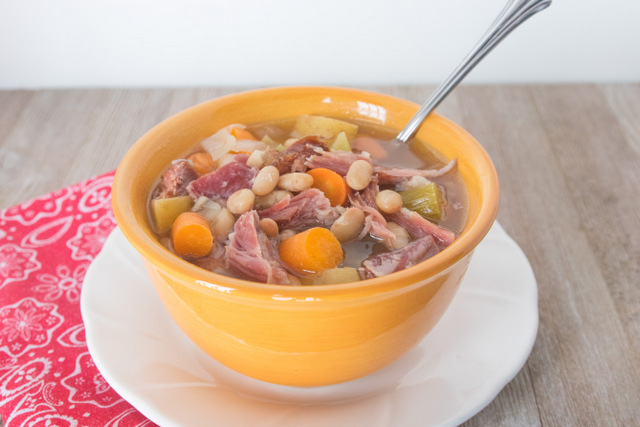
In Praise of Ham and Bean Soup
I’ve never understood why a smoky, delicious ham and bean soup is so hard to find. Heck, just a lackluster, ho-hum ham and bean soup is often hard to find.
I always figured no one knows more about ham and bean soup than Iowa farm cooks, especially when those who grew up on a hog farm like I did. Pork galore in all its forms was a staple on our family’s dinner table for generations. Plus, soup night was always Sunday night at our farm—and it still is. What a treat when ham and bean soup is on the menu!
With its rich broth and smoky undertones, there’s nothing like a hearty ham and bean soup to chase away the winter chill (or bitter cold, depending on what Mother Nature throws at us.) As I’ve refined my own recipe through the years, I’ve come to three conclusions:
1. You MUST have a thick, smoked ham hock (also known as a ham shank) to make the magic. No cubes of cured ham are going to cut it, if you want maximum flavor. This is a heavy-duty, low-and-slow kind of job for a tough, smoky ham shank.
2. We’re blessed to have many great meat lockers in Iowa, a reflection of our thriving livestock industry, where I can get fabulous smoked ham hocks. One of my favorite suppliers? Lewright Meats in Eagle Grove, which has been serving northern Iowa since 1936.
3. Adding diced potatoes is a good thing for ham and bean soup. I like to add oomph to my cooking, and how can you go wrong with extra veggies? Adding potatoes might be a bit non-traditional for ham and bean soup, but that’s how I roll.
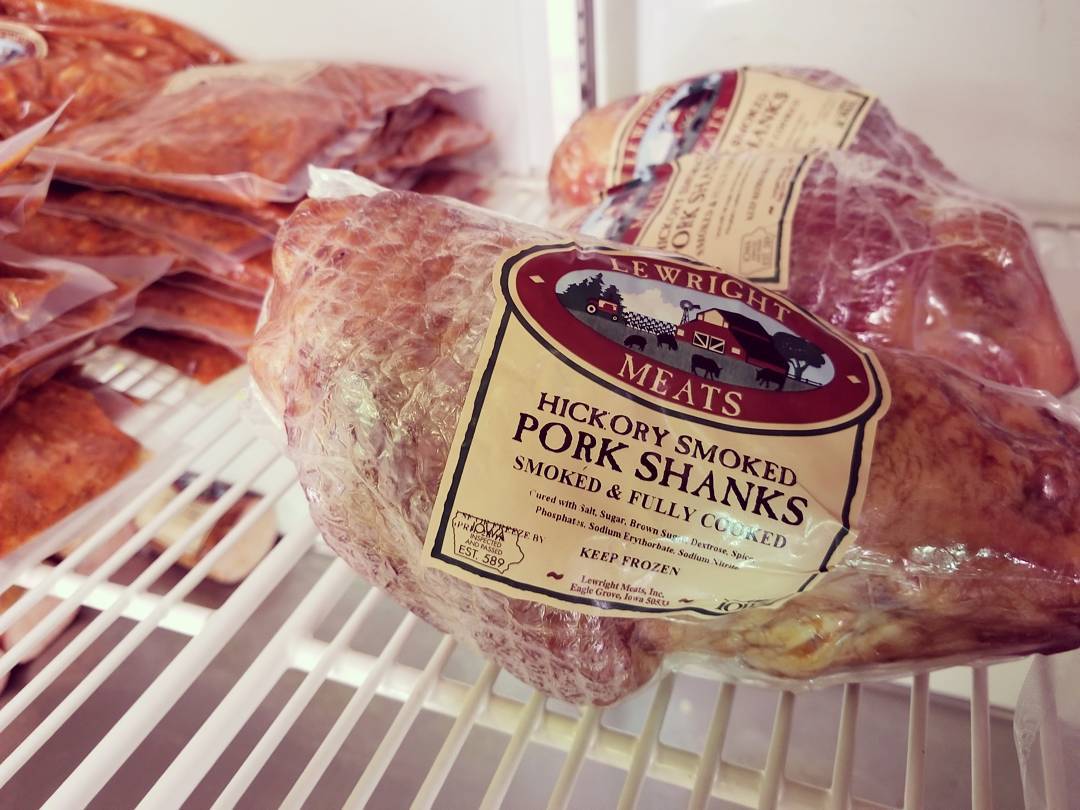
This smoked ham hock from Lewright Meats in Eagle Grove is the key to a great ham and bean soup.
The thing about ham and bean soup is that it can be a palette you fine-tune to your own tastes. Don’t like garlic? Leave it out. Want more onions in the mix? Add another one. (As my dear neighbor and farm cook extraordinaire Alice Ann Dial taught me, onions are a cheap way to add lots of flavor.)
The story behind Congress and Bean Soup
“Thunderation,” roared Speaker of the House Joe Cannon of Illinois. “I had my mouth set for bean soup! From now on, hot or cold, rain, snow, or shine, I want it on the menu every day.”
Obviously, ham and bean soup isn’t just a farm favorite. Turns out it has a rich history in the kitchens of Washington, D.C., too.
While ham and bean soup was a common item on the U.S. House of Representatives’ menu before the turn of the 20th century, it became a permanent fixture in the institution when Speaker Joe Cannon of Illinois discovered that his favorite meal had not been prepared by the kitchen staff on a hot, summer day in 1904.
Cannon, who was the namesake of the Cannon House Office Building, served in the U.S. House for 46 years. Dismayed by that egregious menu omission in 1904, the Speaker directed that bean soup be served in the House every day, regardless of the weather.
More than a century after Speaker Cannon’s decree, bean soup remains on the menu in the House Restaurant, making it one of the more longstanding and famous traditions in the House.
Members of the U.S. House aren’t the only fans of ham and bean soup. It’s also on the menu in the Senate’s restaurant every day. There are several stories about the origin of that mandate, but none has been corroborated.
According to one story, the Senate’s bean soup tradition began early in the 20th-century at the request of Senator Fred Dubois of Idaho. Another story attributes the request to Senator Knute Nelson of Minnesota, who expressed his fondness for the soup in 1903.
The recipe attributed to Dubois includes mashed potatoes and makes a 5-gallon batch. The recipe served in the Senate today does not include mashed potatoes, but does include a braised onion. Click here to check out both Senate recipes.
No matter how you like your ham and bean soup, here’s my take on this American classic. Enjoy, and let me know what you think.
Darcy’s Hearty Ham and Bean Soup
1 smoked ham hock (also called a smoked ham shank)—the meatier, the better
1 48-ounce jar great northern beans (I don’t drain and rinse the beans—I add it all)
3 stalks celery, diced
3 carrots, peeled and sliced
3 to 4 medium potatoes, diced (I prefer Yukon Golds)
1 large onion, chopped
1 tablespoon garlic, minced
1 teaspoon fresh-ground pepper
Water or chicken stock
Salt, to taste
Place ham hock in slow cooker. Add beans, celery, carrots, potatoes, onion, garlic and pepper. Cover with water or chicken stock until slow cooker is full. (If using water rather than chicken stock, I often add 2 or 3 teaspoons of Better Than Bouillon chicken soup base to add more flavor.)
Cook on low for 8 to 10 hours. (I often prepare the soup in the evening and let it cook overnight.) Remove ham hock, allow it to cool, and remove ham from the bone. Add ham back to the soup. Taste the soup to see if it needs salt. Add salt, if desired. (Some ham hocks add enough flavor to the broth that no salt is needed.)
• Note: homemade soup often develops more flavor if you let it sit in the refrigerator overnight and serve the soup the next day. This Hearty Ham and Bean Soup is so good, though, that I understand if you dig in right away!
P.S. Thanks for joining me. I’m glad you’re here.
Want more?
Thanks for stopping by. I invite you to read more of my blog posts if you value intriguing Iowa stories and history, along with Iowa food, agriculture updates, recipes and tips to make you a better communicator.
If you like what you see and want to be notified when I post new stories, be sure to click on the “subscribe to blog updates/newsletter” button at the top of this page, or click here. Feel free to share this with friends and colleagues who might be interested, too.
Also, if you or someone you know could use my writing services (I’m not only Iowa’s storyteller, but a professionally-trained journalist with 20 years of experience), let’s talk. I work with businesses and organizations within Iowa and across the country to unleash the power of great storytelling to define their brand and connect with their audience through clear, compelling blog posts, articles, news releases, feature stories, newsletter articles, social media, video scripts, and photography. Learn more at www.darcymaulsby.com, or e-mail me at yettergirl@yahoo.com.
If you’re hungry for more stories of Iowa history, check out my top-selling “Culinary History of Iowa: Sweet Corn, Pork Tenderloins, Maid-Rites and More” book from The History Press. Also take a look at my latest book, “Dallas County,” and my Calhoun County” book from Arcadia Publishing. Both are filled with vintage photos and compelling stories that showcase he history of small-town and rural Iowa. Order your signed copies today! Iowa postcards are available in my online store, too.
Let’s stay in touch. I’m at darcy@darcymaulsby.com, and yettergirl@yahoo.com.
Talk to you soon!
Darcy
@Copyright 2018 Darcy Maulsby & Co.
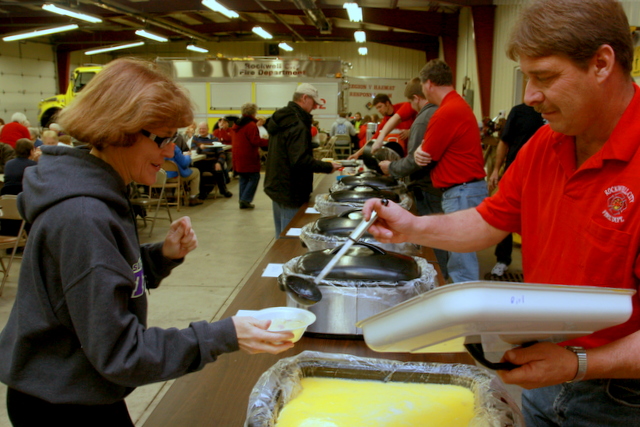
Mmm, Mmm Good: Soup’s on at the Rockwell City Fire Department
While soup is often considered little more than a prelude to something bigger, that’s not the case at the Rockwell City Fire Department. Throughout the winter, roasters filled with homemade chili, cheesy chicken noodle soup and other favorites make the fire station one of the hottest destinations in town.
“We typically serve 300 to 400 people at each supper,” said Duane Murley, a well-known farm broadcaster who has served on the Rockwell City Fire Department for 21 years. “Many times we have a line out the door.”
Murley and his fellow firefighter, Phil Hammen, co-chair the soup suppers, which are held the second Sunday of November, December, January and February from 4 p.m. to 6:30 p.m. at the fire station in Rockwell City. There’s no set fee to attend the soup suppers, which are supported by free-will donations.
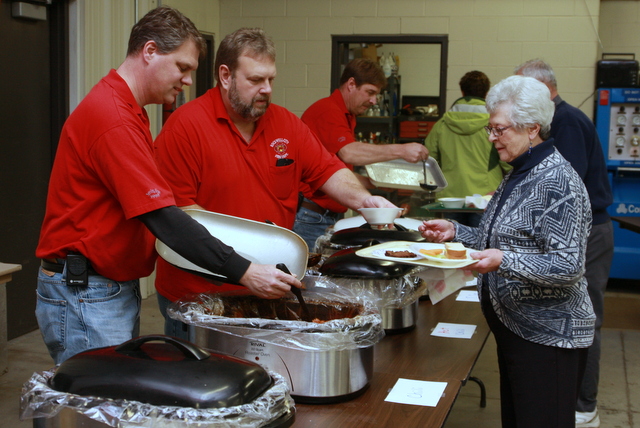
The volunteer firefighters serve two kinds of chili, cheesy chicken noodle soup, 8-Can Soup and more.
“This isn’t so much a money maker as it’s a way for the community to come together,” said Murley, who noted at the soup suppers have been held each winter for nearly seven years.
Many of the guests come from Rockwell City, Lake City, Manson and Twin Lakes. “I like to stop by and help support another local fire department,” said Josh Waller, who serves on the Manson Fire Department and the Calhoun County Farm Bureau board.
While each soup supper includes standard items such as potato soup and chili, the firefighters also mix things up with cheeseburger soup and other options. Each December, local supporters donate ingredients for the oyster stew, which is always a big hit. “They always have lots of good soup here and lots of variety,” said Toni Kerns of Rockwell City.
The firefighters often begin making their soups on Thursday or Friday before the Sunday soup supper. “The key to a good soup is to give it enough time to develop plenty of flavor,” said Phil Hammen, who co-chairs the soup suppers.
Perhaps the simplest—yet most talked-about—menu items are the famous lettuce sandwiches. These are just what they sound like—leaves of lettuce sandwiched between two slices of bread spread with mayonnaise or butter.
“These started as a joke,” said Murley, who recalled his mother-in-law’s stories of eating lettuce sandwiches during her school days at Jolley. “Now people look forward to them so much that we often use seven pounds or more of lettuce during our soup suppers.”
From the lettuce sandwiches to the homemade soups, the firefighters want guests to relax and reconnect with friends and family. “It’s not just about the food,” Murley said. “It’s about being part of the community.”
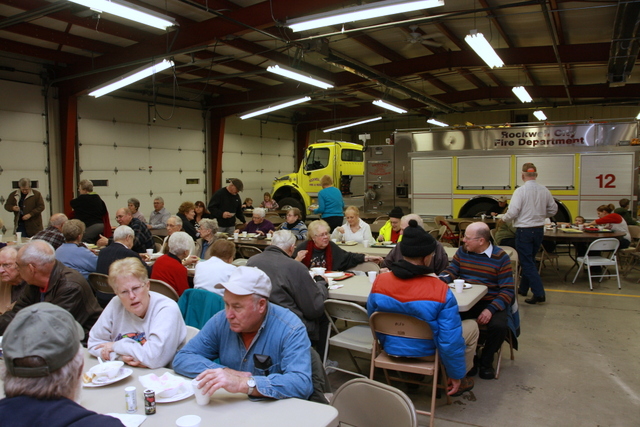
Cold Iowa winter nights don’t deter locals from enjoying the monthly soup suppers at the Rockwell City Fire Department.
8-Can Soup
People often ask if this flavorful soup really contains eight cans of ingredients. Yes it does, says Shane Voith, who has served as Rockwell City’s fire chief, who often multiplies this recipe by five to make this hearty soup for the soup supper.
1 can Hormel chili with beans
1 can Hormel chili, no beans
1 can sliced potatoes, undrained
1 can cut green beans, undrained
1 can whole-kernel corn, undrained
1 can mixed vegetables, undrained
1 can vegetable beef stew
1 can steak and potato soup
1 packet of powdered ranch dressing
Combine all ingredients in a large slow cooker, kettle or roaster. Cook on low all day, or for 2 to 3 hours on high to get the soup hot.
Sweet Chili
Jonathan Wetter, a Rockwell City volunteer firefighter, got this recipe from a friend. It’s reminiscent of both a sweet chili and calico beans.
Half a pound of bacon, cooked and diced
1 pound ground beef, browned
1 can lima beans, drained
1 can butter beans, drained
1 can kidney beans, undrained
1 can pork-and-beans, undrained
1 small onion, chopped
16-ounce can crushed pineapple
1 tablespoon mustard
4 tablespoons molasses
2 tablespoons vinegar
1 / 2 cup brown sugar
1 teaspoon Worcestershire sauce
1 / 2 cup ketchup
Combine all ingredients. Cook on low in a slow cooker or roaster for a few hours until hot.
Firehouse Chili
Duane Murley, co-chair of the fire department’s soup suppers, often makes three roasters of this chili, including one batch with hot peppers for a spicier chili.
7 pounds hamburger, browned
2 gallons Bush’s chili beans
2 gallons diced tomatoes
1 gallon tomato juice
Hot peppers, diced—optional
Cookies Flavor Enhancer, to taste
Chili powder, to taste
Combine all ingredients in a kettle, slow cooker or roaster. Cook on high for several hours or on low all day.
Potato Soup
Phil Hammen, co-chair the fire department’s soup suppers, specializes in this filling Potato Soup. This recipe makes enough to fill one roaster.
15 pounds potatoes, diced and boiled until tender
3 onions, diced
3 ham steaks, cubed
1 1 / 2 gallons 2% milk
2 sticks butter
Combine all ingredients in roaster. Cook until soup is heated through.
Cheesy Chicken Noodle Soup
This perennially popular soup is prepared by firefighter Kyle Welander of Rockwell City. When he cooks for the soup suppers, he boils eight whole chickens, removes the meat from the bones and saves the liquid to make homemade chicken broth.
1/4 cup butter, melted
1/4 cup flour
3 cups chicken broth
1 cup milk
2 cups Velveeta processed cheese, cubed
2 cups egg noodles, cooked
2 cups cooked, diced chicken
Melt butter in a large saucepan and add flour. Add chicken broth and milk. Cook, stirring occasionally on medium-high heat, until the mixture starts to bubble and thicken. Add cubed Velveeta cheese, and stir until melted. Pour mixture into larger pan or kettle. Add 2 cups of cooked egg noodles and 2 cups cooked, diced chicken. Cook on low. To fill a roaster, multiply this recipe by eight.
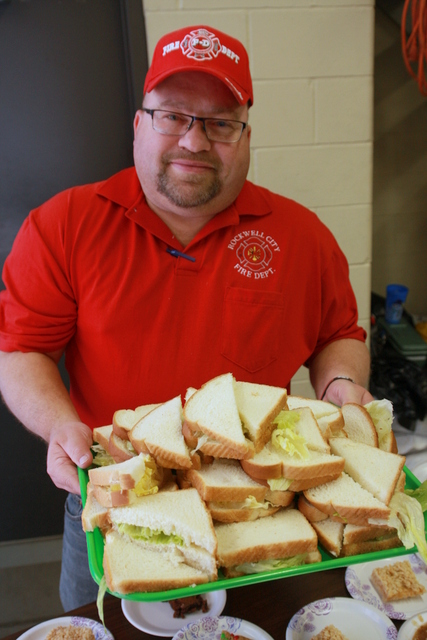
Calhoun County’s Famous Lettuce Sandwiches
Sliced bread
Mayonnaise or butter
Lettuce
Spread slices of bread with mayonnaise or butter. Top the bottom slice with a few leaves of lettuce. Add top slice of bread to complete the sandwich.
Lois Hensel’s Cake
Shelly Hammen of Rockwell City often makes desserts for the fire department’s soup suppers, including this incredible cake that was made famous by Lois Hensel, a long-time cake baker from Lake City. This recipe has been copied from a local cookbook.
2 packages Betty Crocker white cake mix, plus 1 1 / 2 cups from a third box of cake mix
7 / 8 cup egg whites
3 cups water
1 / 2 cup vegetable oil
1 1 / 2 teaspoons almond flavoring
1 / 2 teaspoon butter flavoring
Place cake mixes in mixer bowl. Add 2 cups of water and start mixing. Add egg whites, vegetable oil, almond flavoring, butter flavoring and remaining 1 cup of water. Continue mixing for 2-3 minutes until batter is smooth.
Line two sheet-cake pans (10.5 inches by 15.5 inches by 1 inch) with typing paper (paper may overlap). Pour half of the batter into the first pan. (This should weigh about 3.5 pounds or a bit more.) Place this pan on top oven rack. Bake 10 minutes at the recommended baking temperature on the cake mix box.
Stir the rest of the batter a bit with a spatula. Pour this batter into second cake pan. When first cake tests done (by a light touch of a finger) after about 20 minutes, remove cake from oven. Place second cake on top rack in oven. Bake until done.
Cool the first cake about 10 minutes, and run a knife around the four sides to loosen. Place a few layers of newspaper on both the cake top and on a bigger board. Holding securely, turn cake over onto the board, and peel liner paper off the cake. The brown on top of the cake will now adhere to the newspaper; peel off newspaper.
Place prepared board over cake, holding securely. Turn board and cake over, and place liner paper on cake. Place this in a plastic bag and freeze. It will be easy to trim the four sides with a serrated knife when cake is removed from the freezer.
Have icing ready. Stack four to five piece of 10.5-inch by 15-inch cardboard covered with tinfoil to hold each cake.
Lois Hensel’s Cake Icing
3 / 4 cup egg whites
4 pounds powdered sugar, divided
4 large “blobs” of Crisco shortening
1 teaspoon salt
1 / 2 cup water
1 teaspoon almond flavoring
1 / 2 teaspoon butter flavoring
1 / 2 teaspoon (or more) lemon flavoring
2 teaspoons clear vanilla
Place egg whites in mixer bowl. Add a pound of powdered sugar. Mix, and add shortening and salt. As you continue to mix, add water, remaining powdered sugar, almond flavoring, butter flavoring, lemon flavoring and clear vanilla. Don’t beat—just mix until smooth and until the right consistency is reached, scraping the sides of the bowl with a spatula. Add more powdered sugar, if needed.
This feature originally ran in Farm News.
P.S. Thanks for joining me. I’m glad you’re here.
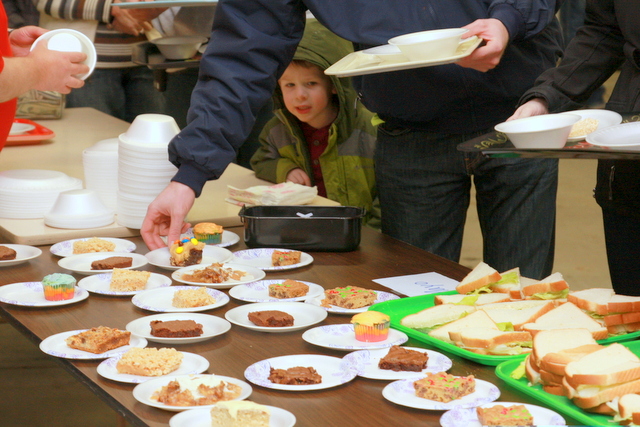
Everyone loves dessert at the soup supper.
Want more?
Thanks for stopping by. I invite you to read more of my blog posts if you value intriguing Iowa stories and history, along with Iowa food, agriculture updates, recipes and tips to make you a better communicator.
If you like what you see and want to be notified when I post new stories, be sure to click on the “subscribe to blog updates/newsletter” button at the top of this page, or click here. Feel free to share this with friends and colleagues who might be interested, too.
If you’re hungry for more stories of Iowa history, check out my top-selling “Culinary History of Iowa: Sweet Corn, Pork Tenderloins, Maid-Rites and More” book from The History Press. Also take a look at my latest book, “Dallas County,” and my Calhoun County” book from Arcadia Publishing. Both are filled with vintage photos and compelling stories that showcase he history of small-town and rural Iowa. Order your signed copies today! Iowa postcards are available in my online store, too.
Also, if you or someone you know could use my writing services (I’m not only Iowa’s storyteller, but a professionally-trained journalist with 20 years of experience), let’s talk. I work with businesses and organizations within Iowa and across the country to unleash the power of great storytelling to define their brand and connect with their audience through clear, compelling blog posts, articles, news releases, feature stories, newsletter articles, social media, video scripts, and photography. Learn more at www.darcymaulsby.com, or e-mail me at yettergirl@yahoo.com.
Let’s stay in touch. I’m at darcy@darcymaulsby.com, and yettergirl@yahoo.com.
Talk to you soon!
Darcy
@Copyright 2018 Darcy Maulsby & Co.
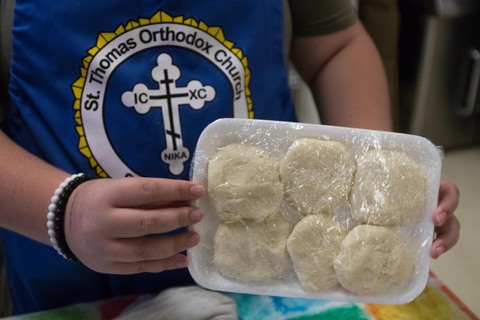
Mediterranean Delights: Iowa Ag Influences Syrian-Lebanese Church Dinner
Call it controlled chaos. Anyone who has ever helped with a church fundraising dinner knows just how hectic, harried and fun it can be to work together to prepare the meals. That’s especially true at St. Thomas Orthodox Church in Sioux City.
“It’s a lot of work and requires all hands on deck,” said Erica Stickney, a chairperson who helps coordinate St. Thomas’s popular Syrian-Lebanese dinner, which was held on Sept. 10 this year.
“While it can get a little frustrating at times when things get really busy and the kitchen’s hot, you remember that it’s about friendship and love, including love for God and the community.”

St. Thomas Orthodox Church has served the Sioux City community since 1916.
Homemade dinners at this year’s Syrian-Lebanese dinner, which was served from 12:30 p.m. to 6 p.m., cost $13 each, with a portion of the proceeds going to The Warming Shelter, a non-profit charity in Sioux City. While this year’s menu served plenty of Mediterranean favorites, many had a Midwestern twist. “Traditionally the meat would have been lamb, but we use beef, because we’re in Iowa,” Stickney said.
The menu included:
• Kibby (or kibbeh). This tasty meatloaf is made with lean ground beef and cracked bulgur wheat, seasoned with cinnamon and allspice.
• Yabrah. Much like cabbage rolls, yabrah includes cabbage leaves that are rolled and stuffed with a spiced blend of beef, rice and tomatoes. “We rolled 5,515 of these this year,” said Sue Stevens of Sioux City. “It’s rewarding to hear our guests say the cabbage rolls are perfect.”
• Lubee. This simple, yet satisfying side dish, features green beans in a tomato and meat sauce.
• Ruz. This Syrian favorite includes buttery white rice accented with tiny orzo pastas.
• Salata. This Syrian salad is enhanced with the church’s special dressing made of oil, vinegar, lemon juice and seasonings.
• Talamee. These big, round loaves of Syrian bread are indescribably tasty, report church members.
• Baklawa. Sometimes called baklava, this classic Mediterranean dessert is made with phyllo pastry dough, butter, and walnuts in a sweet syrup.
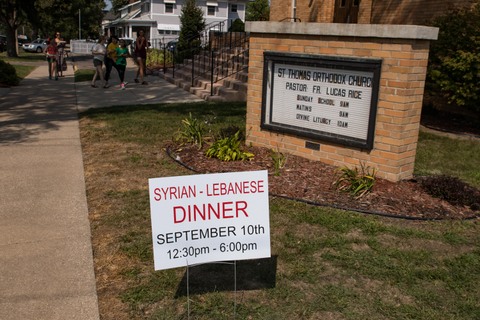
A steady stream of people stopped by St. Thomas Orthodox Church in Sioux City in September 2017 for the popular Syrian-Lebanese dinner.
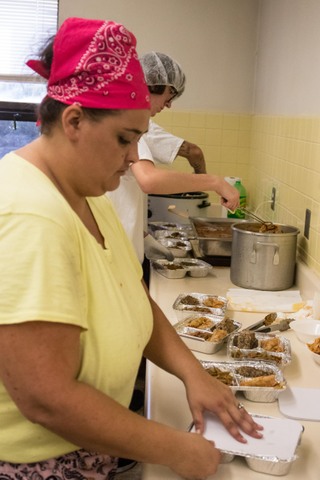
Erica Stickney, a chairperson who helps coordinate St. Thomas’s popular Syrian-Lebanese dinner in Sioux City, dished up countless carryout dinners.
Diverse influences create beloved traditions
While St. Thomas is located in the heart of Sioux City, the parish’s heritage, much like its dinner specialties, reflects a mix of Mediterranean and Midwestern influences. The church was founded in 1916 to serve the needs of Arab Christian immigrants, many of whom came to the area to work in the Sioux City Stockyards or local meatpacking plants. Today’s members embody a diverse background of Mediterranean, Russian, Serbian and Romanian heritage.
“Historically, Sioux City has been very welcoming and accepting of newcomers,” said Father Lucas Rice, who has served the St. Thomas parish more than six years. “When I came here, I was also blown away by how much the people of Siouxland love the St. Thomas church dinner.”
While no one’s sure exactly how long St. Thomas’s congregation has been hosting the dinner (anywhere from 50 years to nearly 80 years, depending on who you ask), there’s no doubt that people mourned the loss of the dinner when the church discontinued it for a few years.
“We hadn’t hosted the dinner in three years, because our church demographics were changing and the older generation was stepping down,” said Stickney, who noted that previous generations cooked without recipes and made their own phyllo dough. “The younger generation had to decide the next steps, and we decided to carry on the tradition.”
Before the older generation retired, younger cooks in the church worked side by side with the experienced cooks so they could observe each step of the process. “We would stop them as they added ingredients so we could determine the measurements and write the recipes,” Stevens said. “While we follow the recipes, we taste the food as we prepare it to make sure it’s right.”
Church members prepared to serve 1,400 dinners on Sept. 10. The process started three weeks before the dinner. “We begin by clarifying the butter,” said Stickney, who noted that 236 pounds of butter are used to prepare the cookies, rice and more. “Clarified butter has the milk solids removed and influences the taste and look of the food.”
The bread is baked on the Saturday right before the dinner, and the rest of the dishes are prepared fresh the day of the church dinner. “I love to come back for this dinner,” said Rick Stevens of Lincoln, Nebraska, whose family has been part of the St. Thomas parish for generations. “This is home.”
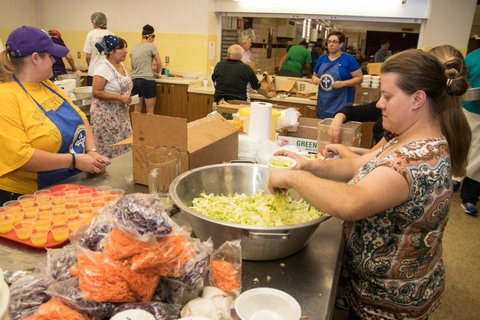
It’s all hands on deck in the basement kitchen at the St. Thomas Orthodox Church Syrian-Lebanese dinner and bake sale in Sioux City.
Clarified Butter
Slowly melt butter in pan on low heat. Be careful not to boil. When butter is completely melted, carefully skim all of the milk fat from the top and discard fat. The result is pure gold butter. This is used in most Arab recipes.
Ghraybeh (Lebanese Butter Cookies)
1 cup clarified butter
1 cup powdered sugar
2 cups flour
With hand mixer, whip butter until creamy pale and fluffy. Add sugar, and mix until fluffy. Using a large rubber spatula, blend in flour a little at a time.
Roll dough into balls and place on cookie sheet. Press to flatten. Work quickly so dough doesn’t get too soft. Bake in preheated oven (300 degrees) until cookies are firm, 10 to 12 minutes. Don’t let cookies get brown. Remove cookies from pan and let cool.

Homemade baklawa (baklava) is always in demand at the St. Thomas Orthodox Church Syrian-Lebanese dinner and bake sale.
Baklawa (also known as Baklava)
4 cups finely chopped walnuts
2 cups clarified butter-melted
1/8 cup granulated sugar
2 packages phyllo dough (20 sheets per package)
Combine walnuts with sugar and 1/4 cup butter so mixture forms a ball when squeezed in your hand.
Grease a large baking sheet with butter. Place one package of phyllo carefully on to baking sheet. Spread walnut mixture on top evenly. Carefully place second package of phyllo
on top of walnut mixture. Carefully take off top five layers of phyllo.
Butter the top layer of phyllo dough on the pan, and then place a single layer of phyllo on top of buttered layer. Repeat until all lawyers are back on to pan. Put butter on top layer. Cut into diamond shapes.
Bake in preheated, 375-degree oven for 25 minutes. Remove from oven. Pour a little butter on the top evenly. Place pan back into the oven for another 20 minutes or so, until the baklawa is golden brown.
Remove pan from oven and place on cooling rack. Immediately pour syrup mix (see recipe below) evenly on top of entire pan. Let pan sit for one day. Allow syrup to soak through the entire dessert. You may want to re-cut baklawa before removing from pan.
Syrup for Baklawa
2 1/2 cups granulated sugar
1 1/2 cups water
1 tablespoon lemon juice
In a pan, heat water and sugar until boiling. Once mixture starts to boil, add the lemon juice. Cook for another 15 minutes until the syrup starts to thicken. Remove pan from heat, and set aside to cool.
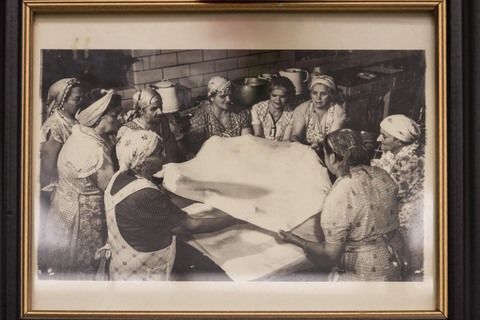
Previous generations of church members made their own phyllo dough at St. Thomas Orthodox Church in Sioux City, Iowa.
Barazek (Sesame Cookies)
1 cup butter
1/2 cup sugar
1 egg
1/2 teaspoon vanilla
3 cups flour
1/4 teaspoon salt
1 teaspoon baking powder
1/2 cup milk
3 tablespoons pistachios chopped
1 egg white
3 tablespoons sesame seeds
Preheat oven to 350 degrees. Cream butter and sugar with electric mixer until light and fluffy. Add egg and vanilla, continue beating. In separate bowl, mix flour, salt and baking powder. Stir flour mixture gradually into butter mix, alternating with milk.
Knead dough on lightly floured surface. Divide dough into two parts. Roll each piece into a circle, and cut into rounds. Place pistachios on a cookie sheet; spread evenly. Place dough rounds on top of pistachios, and press lightly. Beat the egg bite and then brush the tops of cookies. Sprinkle with sesame seeds. Bake about 15 minutes, or until golden brown.
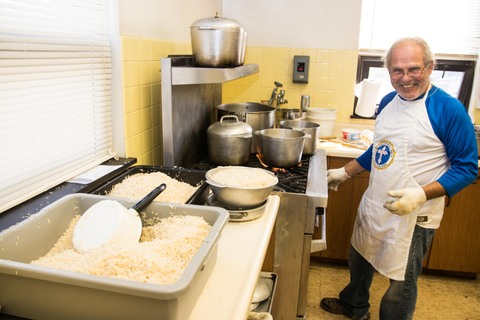
Ruz (a Syrian favorite of buttery white rice accented with tiny orzo pastas) is cooked in large quantities at the St. Thomas Orthodox Church Syrian-Lebanese dinner.
Want more?
Thanks for stopping by. I invite you to read more of my blog posts if you want more more intriguing Iowa stories and history, along with Iowa food, recipes and tips to make you a better communicator.
If you like what you see and want to be notified when I post new stories, be sure to click on the “subscribe to blog updates/newsletter” button at the top of this page. Feel free to share this information with friends and colleagues who might be interested, too.
If you’re hungry for more stories of Iowa history, check out my top-selling “Culinary History of Iowa: Sweet Corn, Pork Tenderloins, Maid-Rites and More” book from The History Press. Also take a look at my latest book, “Dallas County,” and my Calhoun County” book from Arcadia Publishing. Both are filled with vintage photos and compelling stories that showcase he history of small-town and rural Iowa. Order your signed copies today! Iowa postcards are available in my online store, too.
Let’s stay in touch. I’m at darcy@darcymaulsby.com, and yettergirl@yahoo.com.
P.S. Thanks for joining me. I’m glad you’re here.
@Copyright 2017 Darcy Maulsby & Co.
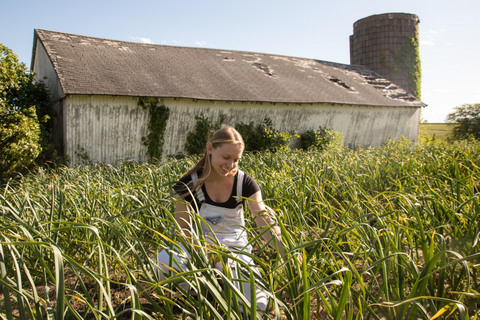
Ultra-Local Eating: Jennifer Miller Guides CSA, Iowa Food Cooperative
Jennifer Miller could hardly believe the question. “When will your bananas be ready?” inquired a central Iowa woman who was buying fresh produce through Miller’s Clarion Sage market garden and community supported agriculture (CSA) business near Waukee.
“People are disconnected from where their food comes from,” said Miller, 30, who noted the woman seeking locally-grown bananas is a well-educated business professional. “I’ve even had people look at our heirloom tomatoes and say, ‘I don’t want those,’ because they think they are GMOs.’”
This disconnect isn’t all that foreign to Miller, who grew up in Highland Park, Illinois, a northern suburb of Chicago. “I had no contact with agriculture in Highland Park,” said Miller, who serves as the Iowa Food Cooperative’s member services coordinator.
Miller did have a connection with Iowa, though, through her paternal grandparents, who lived in the Clarion/Rowan area. Her decision to move to Iowa in 2010 was spurred, in part, by a health challenge and new-found passion for healthy eating.
Miller was diagnosed a number of years ago with celiac disease, a serious autoimmune disorder where consuming gluten can damage the small intestine. “I started caring more about cooking and healthy recipes, because I just wanted to feel better,” said Miller, whose gluten-free and vegan recipes on her blog caught the attention of Martha Stewart Living editors, who invited her to develop recipes for them. “That’s what got me into food and agriculture.”
Food can be so much more interesting
After moving to Iowa, Miller got involved with community gardens in the Des Moines area and became a marketing/communications specialist Iowa Food Cooperative, which operates like an online farmers market. In 2013, Miller and her partner, Cody Kilgore, moved to an acreage on the southwest edge of Waukee’s city limits in Van Meter Township so they could operate their own farm.
“It felt like coming full circle,” said Kilgore, who was raised in rural Missouri, worked in the corporate world for nearly 30 years and was ready for a career switch.
 The couple planted garlic in the fall of 2013 to start their Clarion Sage market garden. The goal? “We believe in ultra-local and want to feed the community around us,” said Miller, who noted that Clarion Sage primarily serves families within a five-mile radius in southern Dallas County.
The couple planted garlic in the fall of 2013 to start their Clarion Sage market garden. The goal? “We believe in ultra-local and want to feed the community around us,” said Miller, who noted that Clarion Sage primarily serves families within a five-mile radius in southern Dallas County.
Today, Miller and Kilgore raise a wide array of vegetables and herbs, including lettuce, squash, cabbage, carrots, garlic, tomatoes, cucumbers, peppers, potatoes and more, including heirloom varieties that can’t be found in most stores. They offer an online ordering system for added convenience.
“Food can be so much more interesting,” Miller said. “Whether you’re sharing a family meal, providing snacks for your kids or making a favorite recipe, one thing’s for sure: the starting point for all these is good food.”
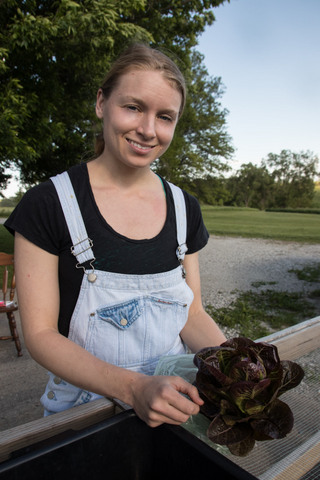
Jennifer Miller displays one of the unique lettuce varieties she grows at Clarion Sage Farm near Waukee.
Six lessons learned about farming and food
As their business evolved, Miller and Kilgore have adjusted their marketing plan to adapt to the often surprising—and sometimes frustrating—buying patterns they’ve observed in the market. The Clarion Sage market garden and CSA have taught them six key lessons, including:
1. Farming is more than production. Raising an abundant crop is just step one, said Miller, who has learned that that marketing and sales are equally important.
2. Mentors matter. “I didn’t grow up gardening, so working for various produce growers in Iowa and beyond taught me so much,” said Miller, who is grateful for leaders like Angela Tedesco who started Turtle Farm near Granger, Jill Beebout from Blue Gate Farm near Chariton and other local food proponents who have mentored her along the way.
3. Buying local adds flavor to life. Clarion Sage’s customers appreciate the “know your farmer” philosophy. Most buyers tend to be in their 30s and 40s with families, or they’re retired and have an interest in good food and time to cook. “Every week we offer our customers about $30 worth of fresh vegetables,” Miller said. “We focus on staple items like lettuce, potatoes, carrots and tomatoes, with the opportunity for more exotic options like stir-fry greens, kale and eggplant.”
4. Catering to consumers can be tricky. While the Clarion Sage CSA is right on Waukee’s doorstep, some consumers don’t want to drive to the farm to pick up vegetables. Some feel they don’t have time, while others don’t like the way the gravel road makes their vehicle dusty. When Miller tried offering delivery, some consumers still rejected this option, citing a lack of time or interest in preparing fresh food. Even full-color newsletters filled with cooking tips and recipes failed to gain much traction with these types of consumers, said Miller, who plans to start selling her produce at the Downtown Farmers’ Market in Des Moines.
5. Urban sprawl is relentless. High-density residential projects are planned for the area near the Clarion Sage’s market garden. “We’re in the bullseye of urban sprawl, which is a challenge,” said Kilgore, who also works as a wedding photographer.
6. Local food pairs well with global flavors. Miller loves ethnic cooking, from Latin American to African. “If you want to add more vegetables to your diet, look to other cultures that don’t have an abundance of meat protein,” said Miller, who encourages people to try vegetables like Cherokee Purple heirloom tomatoes (known for their smoky, complex flavor), fish peppers (which pack more heat), Merlot lettuce (whose dark red leaves offer a mellow flavor) and fingerling potatoes (which taste great fried or roasted).
Food is one of the best parts of life, added Miller, who loves the creativity involved in growing and marketing a crop. “You see a crop through from beginning to end, and you’re producing something that can feed and sustain people. That’s amazing to me.”
Want more?
Thanks for stopping by. I invite you to read more of my blog posts if you want more more intriguing Iowa stories and history, along with Iowa food, recipes and tips to make you a better communicator. If you like what you see and want to be notified when I post new stories, be sure to click on the “subscribe to blog updates/newsletter” button at the top of this page. Feel free to share this information with friends and colleagues who might be interested, too.
If you’re hungry for more stories of Iowa history, check out my top-selling “Culinary History of Iowa: Sweet Corn, Pork Tenderloins, Maid-Rites and More” book from The History Press, as well as my Calhoun County” book from Arcadia Publishing, which showcases the history of small-town and rural Iowa. Order your signed copies today! Iowa postcards are available in my online store, too.
Let’s stay in touch. I’m at darcy@darcymaulsby.com, and yettergirl@yahoo.com.
P.S. Thanks for joining me. I’m glad you’re here.
@Copyright 2017 Darcy Maulsby & Co.
About me:
Some people know me as Darcy Dougherty Maulsby, while others call me Yettergirl. I grew up on a Century Farm between Lake City and Yetter and am proud to call Calhoun County, Iowa, home. I’m an author, writer, marketer, business owner and entrepreneur who specializes in agriculture. Learn more at www.darcymaulsby.com.
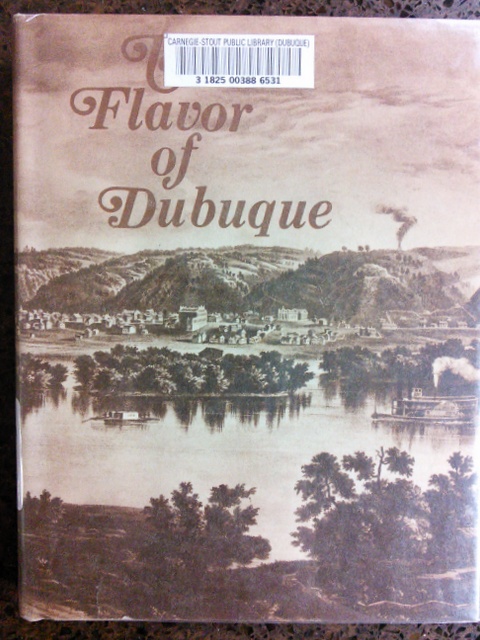
Let’s Have an Iowa Potluck with a Side of History!
Dubuque is home to some of Iowa’s most distinctive culinary traditions, from turkey dressing sandwiches to the memorable meals served at the iconic Hotel Julien Dubuque. We’re going to be eating up all this local flavor at a potluck on Sept. 7 at the Carnegie-Stout Public Library in Dubuque, starting at 5:30 p.m., followed by my “Culinary History of Iowa” program—and you’re invited!
Click here for all the details.
In meantime, here’s a sample of some classic Dubuque recipes to tempt you. These recipes come from a variety of sources, including two cookbooks (including The Flavor of Dubuque and Another Flavor of Dubuque) compiled by The Women’s Auxiliary of the Dubuque Symphony Orchestra. Not only do those cookbooks include tried-and-true local recipes, but they feature many photos of local landmarks. The third cookbook (Cedar Ridge Farm Recipes) appears to have been a collection of family recipes, and librarian Sarah Smith isn’t sure how it came to be in the Carnegie-Stout’s collection, but it’s charming.
Thanks, Sarah, for sharing these recipes and offering us a true taste of Dubuque!
One more thing–if you’re in Dubuque, stop by Cremer’s Grocery, a Dubuque classic since 1948, for their famous turkey dressing sandwiches and other goodies! Also, here are some fun facts about Dubuque, an All-American City that’s truly a “Masterpiece on the Mississippi:”
- Dubuque was settled by a French Canadian fur trader in the late 1700s named Julien Dubuque. In those days, Dubuque was known as the “gateway to the west.” Lead mining soon became the mainstay of Dubuque.
- There has been some type of hotel on the site of the Hotel Julien Dubuque since 1839.
- Some cool things to see in Dubuque include the National Mississippi River Museum and Aquarium, along with the Fenelon Place Elevator Company, which is the world’s shortest, steepest elevator ride!

Source: American Realty
The Flavor of Dubuque (published 1971)
Page 26
Derby Grange Steak. The present owners of what was the main farmstead in the area west of Dubuque long known as Derby Grange found this recipe behind an old picture of President Harding left by the previous owners. Cut 1 thick round steak into 1-inch pieces. Pound very thin and sprinkle with flour, salt, pepper, a little cumin and dill. Poud again and brown pieces on both sides in a little butter or other fat. Place in baking dish and pour over 1 cup tomato sauce. Bake, covered, at 300 degrees for 1 hour. Serves 7. Can be frozen. -Joan Mulgrew
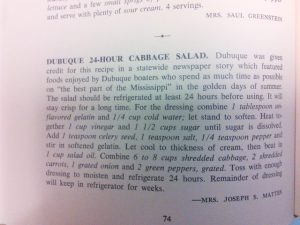
A Dubuque original –24-Hour Cabbage Salad
Page 74
Dubuque 24-Hour Cabbage Salad. Dubuque was given credit for this recipe in a statewide newspaper story which featured foods enjoyed by Dubuque boaters who spend as much time as possible on “the best part of the Mississippi” in the golden days of summer. The salad should be refrigerated at least 24 hours before using. It will stay crisp for a long time. For the dressing combine 1 tablespoon unflavored gelatin and 1/4 cup cold water; let stand to soften. Heat together 1 cup vinegar and 1 1/2 cups sugar until sugar is dissolved. Add 1 teaspoon celery seed, 1 teaspoon salt, 1/4 teaspoon pepper and 1 cup salad oil. Combine 6 to 8 cups shredded cabbage, 2 shredded carrots, 1 grated onion and 2 green peppers, grated. Toss with enough dressing to moisten and refrigerate 24 hours. Remainder of dressing will keep in refrigerator for weeks. -Mrs. Joseph S. Mattes
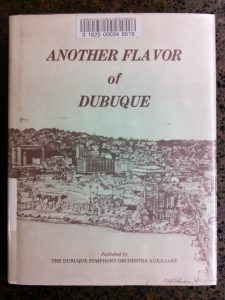
More recipes from Dubuque, Iowa
Another Flavor of Dubuque (published 1983)
Page 70
Welsh Rarebit. Shred 1/2 pound Cheddar cheese, put in double boiler and let melt slowly over hot water. Keep water below boiling point. Add 1/4 teaspoon dry mustard, paprika, salt and a few dashes cayenne pepper. Stir in 1 cup milk or cream and 1 teaspoon Worcestershire sauce. Mixture should be smooth and velvety. Serve on hot buttered toast. Strips of bacon are especially good over this.
Welsh Rarebit became a traditional Sunday night supper in the girls’ boarding school at Sinsinawa Mound (this is technically across the river in Wisconsin, but many of the students would have been from Dubuque.) The recipe’s simplicity and flexibility accommodated the varying number of returning students each Sunday night. It was sometimes served over tomatoes or ham. -Bette F. Schmid
Page 156
Dubuque Symphony Orchestra Auxiliary English Toffee. This delicious toffee was sold at the 1981 Designer Showcase, and the Auxillary has had many, many requests for the recipe. Line cookie sheet with foil. In heavy pan mix 1 cup sugar, 1/2 pound butter, 1/4 cup water, 1/4 teaspoon salt, 1/2 teaspoon vanilla and 1 cup chopped pecans. Cook quickly over medium high heat, stirring constantly, to a rolling boil. Cook to hard crack stage, 300 degrees on candy thermometer. Pour on cookie sheet. Cool and break into pieces. Store in air tight container. Do not freeze, refrigerate or make substitutions in recipe. -Mary Stauffer
Cedar Ridge Farm Recipes by Rita Tarnutzer Montgomery (published 1999)
Page 69
Chocolate Chip Cookies (Monster Cookies)
1/2 cup margarine
1/2 cup shortening
1 cup brown sugar
1 cup white sugar
1 teaspoon vanilla
2 eggs
1 cup oatmeal
1 cup corn flakes
2+ cups flour
1 teaspoon baking powder
1 teaspoon baking soda
12 ounces chocolate chips
Bake for 10-12 minutes at 350 degrees.
NOTE from Rita: For Monster Cookies, form into 5 oz. balls and flatten into 7-inch diameter circles, two to a cookie sheet. Bake for about 14 minutes at 350 degrees. Makes 8 cookies.
In 1976, when Al had his first antique shop, on 16th and Central Ave., he had a huge glass cookie jar. His idea was to display a couple of really big cookies in it. Everyone wanted to buy them! So, I began baking these monster cookies, 32 at a time and selling them for twenty-five cents each. (They cost twelve cents each to make.) I couldn’t keep up with the demand, so he raised the price to thirty-five cents and still they sold. School kids stopped on their way home from school and bought a cookie to share!
Page 159
Turkey & Dressing Sandwiches
from Janet Duscher, 12/88
Bake in a covered roaster until meat falls from bones: 1 – 12 lb. turkey
Remove meat from bones and chop.
Cook together:
1 1/2 cups cooking juices
3/4 cup margarine
2 1/2 cups chopped celery
3 medium onions, chopped
2 tablespoons sage
2 teaspoons poultry seasoning
1 – 1 ½-ounce package dry onion soup mix
1 – 10 3/4 ounces cream of chicken soup
Cube: 2 loaves of day-old bread (about 6 quarts)
Stir together bread cubes, juices with vegetables and seasonings and turkey.
Bake in a greased pan at 350 degrees until heated thoroughly, about one hour.
Serve hot in buns.
Want more?
Thanks for stopping by. I invite you to read more of my blog posts if you want more more intriguing Iowa stories and history, along with Iowa food, recipes and tips to make you a better communicator. If you like what you see and want to be notified when I post new stories, be sure to click on the “subscribe to blog updates/newsletter” button at the top of this page. Feel free to share this information with friends and colleagues who might be interested, too.
If you’re hungry for more stories of Iowa history, check out my top-selling “Culinary History of Iowa: Sweet Corn, Pork Tenderloins, Maid-Rites and More” book from The History Press, as well as my Calhoun County” book from Arcadia Publishing, which showcases the history of small-town and rural Iowa. Order your signed copies today! Iowa postcards are available in my online store, too.
Let’s stay in touch. I’m at darcy@darcymaulsby.com, and yettergirl@yahoo.com.
P.S. Thanks for joining me. I’m glad you’re here.
@Copyright 2017 Darcy Maulsby & Co.
About me:
Some people know me as Darcy Dougherty Maulsby, while others call me Yettergirl. I grew up on a Century Farm between Lake City and Yetter and am proud to call Calhoun County, Iowa, home. I’m an author, writer, marketer, business owner and entrepreneur who specializes in agriculture. Learn more at www.darcymaulsby.com.


